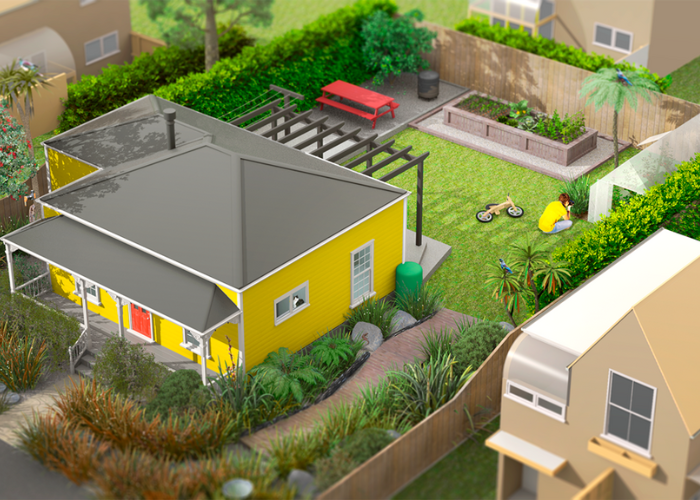Sustainable living is no longer just a buzzword; it’s a necessity. As we grapple with the consequences of climate change, dwindling resources, and environmental degradation, adopting sustainable practices in our daily lives has become imperative. One of the most tangible ways to contribute to a greener future is by nurturing nature right in our homes and gardens. This article explores how you can transform your living space into a sustainable haven, benefiting both the environment and your well-being.
The Urgency of Sustainable Living
Before delving into the ways to create a sustainable home and garden, let’s underscore why it’s crucial. Climate change, habitat loss, pollution, and the depletion of natural resources are among the most pressing challenges of our time. These issues are interconnected and have far-reaching consequences, from extreme weather events to the loss of biodiversity, and even threats to food security.
Sustainable living addresses these challenges head-on by reducing our ecological footprint and promoting responsible consumption. It’s about making choices that minimize negative impacts on the environment, conserve resources, and create a healthier, more equitable world for current and future generations.
Creating a Sustainable Home
Our homes are where we spend a significant portion of our lives. Making them sustainable can have a substantial impact. Here are some ways to do it:
Energy Efficiency
One of the most effective ways to reduce your environmental impact is to make your home more energy-efficient. This involves:
- Insulation: Proper insulation keeps your home warm in winter and cool in summer, reducing the need for heating and cooling.
- Energy-Efficient Appliances: Upgrade to energy-efficient appliances, such as LED light bulbs, ENERGY STAR-rated appliances, and smart thermostats.
- Solar Panels: Consider installing solar panels on your roof to generate clean, renewable energy and reduce your reliance on fossil fuels.
Water Conservation
Water is a precious resource, and conserving it is vital. Implement these practices:
- Low-Flow Fixtures: Install low-flow faucets, showerheads, and toilets to reduce water consumption.
- Rainwater Harvesting: Collect rainwater in barrels to water your garden and indoor plants.
- Drought-Tolerant Landscaping: Choose drought-resistant plants for your garden to reduce the need for irrigation.
Waste Reduction
Minimizing waste is a fundamental aspect of sustainability. Here’s how:
- Reduce, Reuse, Recycle: Follow the three Rs diligently. Reduce your consumption, reuse items when possible, and recycle materials like paper, glass, and plastic.
- Composting: Start a compost bin to turn kitchen scraps and yard waste into nutrient-rich soil for your garden.
- Waste Auditing: Periodically assess your waste production to identify areas for improvement.
Sustainable Materials
Consider the materials used in your home:
- Bamboo Flooring: Opt for sustainable flooring materials like bamboo, which grows quickly and can be harvested without harming the plant.
- Recycled and Upcycled Furniture: Choose furniture made from recycled or upcycled materials.
- Non-Toxic Paints: Use paints with low or no volatile organic compounds (VOCs) to improve indoor air quality.
Green Transportation
Reduce your carbon footprint by adopting greener transportation options:
- Carpooling: Share rides with others to reduce the number of vehicles on the road.
- Public Transit: Use public transportation when possible, reducing the emissions associated with individual car travel.
- Bicycling: Consider cycling for short trips; it’s both eco-friendly and promotes personal health.
Sustainable Gardening
Your garden can be a haven for biodiversity and a source of fresh produce. Here’s how to make it sustainable:
Native Plants
Plant native species in your garden. Native plants are adapted to your region’s climate and support local wildlife.
Organic Gardening
Practice organic gardening methods to reduce the use of harmful pesticides and synthetic fertilizers.
Composting
As mentioned earlier, composting kitchen and garden waste enriches your soil naturally.
Rain Gardens
Create rain gardens or bioswales to manage rainwater runoff and prevent soil erosion.
Bee-Friendly Gardens
Plant flowers that attract pollinators, such as bees and butterflies, to support essential ecosystem services.
Wildlife-Friendly Practices
Promote biodiversity in your garden by providing habitats for wildlife:
- Birdhouses and Feeders: Install birdhouses and feeders to attract a variety of avian visitors.
- Ponds and Water Features: Small ponds or water features can provide water and habitat for amphibians, insects, and birds.
- Wildlife-Friendly Plants: Include plants that offer food and shelter for wildlife, like berry-bearing shrubs and native grasses.
Permaculture
Permaculture is a holistic approach to gardening that mimics natural ecosystems. It emphasizes sustainability, self-sufficiency, and biodiversity.
Benefits of Sustainable Living at Home and in the Garden
Now that we’ve explored the ways to create a sustainable home and garden, let’s delve into the benefits of these practices:
Reduced Environmental Impact
Sustainable living significantly reduces your carbon footprint. By using energy and resources more efficiently, you help mitigate climate change, reduce habitat destruction, and limit pollution.
Lower Utility Bills
Energy-efficient homes consume less power, which translates to lower electricity bills. Similarly, water-saving measures reduce water bills.
Healthier Living
Sustainable homes often have better indoor air quality due to the use of non-toxic materials and improved ventilation. This can lead to a healthier living environment for you and your family.
Connection to Nature
Gardening, especially when done sustainably, connects you to the natural world. It provides an opportunity to observe and appreciate the rhythms and cycles of nature.
Food Security
Growing your own food in a sustainable garden can contribute to your food security. It also reduces the carbon footprint associated with transporting food long distances.
Biodiversity Conservation
Sustainable gardens, particularly those with native plants and wildlife-friendly features, provide essential habitat for local wildlife. This contributes to biodiversity conservation, which is crucial for ecosystem health.
Economic Savings
While there may be upfront costs to make your home and garden more sustainable, the long-term savings on utility bills, groceries, and healthcare can be substantial.
Challenges and Considerations
While sustainable living offers numerous benefits, it’s essential to acknowledge the challenges and considerations involved:
Initial Costs
Implementing sustainable practices in your home and garden may require an initial financial investment. However, many sustainable changes pay for themselves over time through lower utility bills and reduced expenses.
Lifestyle Adjustments
Sustainable living often requires changes to your lifestyle and daily routines. It may take time to adapt to these changes fully.
Education and Research
To make informed sustainable choices, you may need to invest time in research and education. This can include learning about local native plants, sustainable gardening techniques, and energy-efficient home improvements.
Space Constraints
Not everyone has ample space for gardening or renewable energy installations. In such cases, creativity is essential to find sustainable solutions within the available space.




